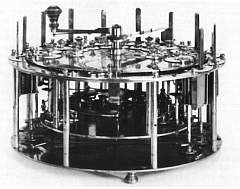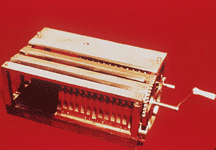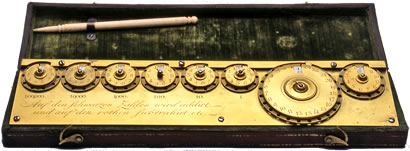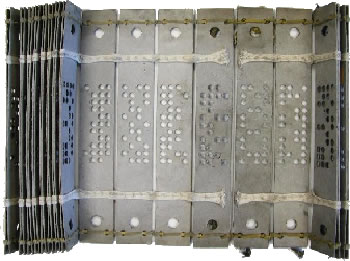click on the home button to go to the home page
|
The era of Antiquity (continued) 1773 - 1809 The era of Antiquity can be seen as the era of calculator devices without memory. Dial or indicators serve as output mechanism.
|
pre history | antiquity
| pre industrial era | industrial
era
1620 -
1672 - 1773
- 1810 - 1830 - 1846
- 1874
| Related Articles |
| Robotics |
| Related Resources |
|
pre history |
![]() Pierre and Henry Louis Jaquet-Droz (Swiss) invented the first
automaton that could write. Soon after that they build another automaton that
drew a portrait of King Louis XV. Taking the word 'robot' in a broad sense,
we might say that these machines were some of the first robots.
Pierre and Henry Louis Jaquet-Droz (Swiss) invented the first
automaton that could write. Soon after that they build another automaton that
drew a portrait of King Louis XV. Taking the word 'robot' in a broad sense,
we might say that these machines were some of the first robots.
read ![]() on robotics
on robotics
 |
|
| |
 (13b) (13b) |
![]() Stanhope continued
to construct new machines. Neither of Stanhope's machines embodied new
mechanical systems, but they were ruggedly constructed and more reliable then
others. Technical skills now had a chance to catch up with inventive capacity.
Stanhope continued
to construct new machines. Neither of Stanhope's machines embodied new
mechanical systems, but they were ruggedly constructed and more reliable then
others. Technical skills now had a chance to catch up with inventive capacity.

Stanhope also devised and
published a simple machine that mechanized logical relations. This was the beginning
of a new attitude in which computers were considered as mechanical embodiments
of generalized mathematical processes, rather than simple arithmetic machines.(13b)
![]() Charles Mahon invented the logic demonstrator. A device that
solved arithmetic problems in a logical form.
Charles Mahon invented the logic demonstrator. A device that
solved arithmetic problems in a logical form.
![]() Charles Stanhope
demonstrated his logical calculator. This machine clearly demonstrated that
when one has a good "method of calculation and logic" it should be
possible to built this logic into machines that made logical decisions. But
Stanhope's machines left much to the operator for interpretation, which made
the machine difficult to use and the outcome questionable.
Charles Stanhope
demonstrated his logical calculator. This machine clearly demonstrated that
when one has a good "method of calculation and logic" it should be
possible to built this logic into machines that made logical decisions. But
Stanhope's machines left much to the operator for interpretation, which made
the machine difficult to use and the outcome questionable.
|
Think about this... This problem of user interface and ease of use is a common problem, and it will probably take a long time before enough intelligence is built into machines that they can solve problems before they occur. Maybe the ease-of-use versus necessary training-to-use aspect will never be solved, because systems get more complicated all the time. To solve it you need something that is even more complicated, but that will cause again new problems etc. etc. |
It was one of the earliest logical machines though. Stanhope's use of it might again be questionable in the light of pure logic but the idea was born and was going to be very important for the future development of computers.
 |
![]() In a letter Johann Mueller (1746-1830) wrote about his intention
to build a machine that could calculate every form of calculation and print
the answers. "All one has to do is to turn a handle". This letter
contained the earliest reference of a machine that would also print the results.
In another letter he described plans for a machine to calculate square roots
and cubes by means of series of differences. Mueller envisioned the difference
engine 36 years before Babbage!.(8)
In a letter Johann Mueller (1746-1830) wrote about his intention
to build a machine that could calculate every form of calculation and print
the answers. "All one has to do is to turn a handle". This letter
contained the earliest reference of a machine that would also print the results.
In another letter he described plans for a machine to calculate square roots
and cubes by means of series of differences. Mueller envisioned the difference
engine 36 years before Babbage!.(8)
![]() Details of J.H. Muellers' machine will be published in
a book of which chapters have been translated for Charles
Babbage by John Hershel. The date of this translation is unknown and the
question remains whether some of Mueller's ideas have been used for Babbage's
machine.
Details of J.H. Muellers' machine will be published in
a book of which chapters have been translated for Charles
Babbage by John Hershel. The date of this translation is unknown and the
question remains whether some of Mueller's ideas have been used for Babbage's
machine.
But that will be the case for many inventions in the history (of computing)
to come.(16) Especially when money is involved, people or
companies will object and demand a royalty to be paid (17)
or will otherwise force the user to pay a fine and remove the invention from
his work(s).
![]() Edward (Nedd) Ludd (England), was not fully witted as is said,
and destroyed sock knitting machines. He became the talisman of a movement starting
in Nottingham, England, that consisted of uncontended workers moving through
England, whom destroyed all kinds of machines on their way. Ludd's followers
have the following credo: "No the general but Ludd looks after the interest
of the poor men".(15)
Edward (Nedd) Ludd (England), was not fully witted as is said,
and destroyed sock knitting machines. He became the talisman of a movement starting
in Nottingham, England, that consisted of uncontended workers moving through
England, whom destroyed all kinds of machines on their way. Ludd's followers
have the following credo: "No the general but Ludd looks after the interest
of the poor men".(15)
This group caused a path of destruction through England until 1815. At night
they wore masks and broke into workshops and factories to destroy looms, machines
or anything that looked like mass production. Their idea was that all this machinery
(mechanization and automation) would put them out of jobs. And they where (temporarily)
not far from the truth. This is not the first time people rise against technology
but it is the first time a movement like that left a word: Luddite. A Luddite
is someone resisting new technology.

![]() Electricity was pulled from oblivion by Alessandro
Volta. And by experimenting, he succeeded to build the so-called Voltaic
Element (see figure), a primitive battery that was constructed from layers
of copper and silver plates with pieces of leather or cardboard in between.
This contraption was put in a salty solution and produced electrical current.
Electricity was pulled from oblivion by Alessandro
Volta. And by experimenting, he succeeded to build the so-called Voltaic
Element (see figure), a primitive battery that was constructed from layers
of copper and silver plates with pieces of leather or cardboard in between.
This contraption was put in a salty solution and produced electrical current.
Among one of his experiments with electricity was a demonstration for Napoleon to prove that you could twitch frog legs with the help of electricity. Since Napoleon regarded science as a means of warfare, and Napoleon was interested enough to sponsor Volta.

Auch calculator
picture: courtesy Boerhave museum, Leiden, Netherlands
![]() A more advanced Pacaline 'calculator' is
made by Jacob Auch, royal machanic at the Weimar court (Germany) a very rare
machine to add and substract. At the lower left there is an instruction on the
machine in German: use black to add and red to substract.
A more advanced Pacaline 'calculator' is
made by Jacob Auch, royal machanic at the Weimar court (Germany) a very rare
machine to add and substract. At the lower left there is an instruction on the
machine in German: use black to add and red to substract.
|
Joseph-Marie Jaquard
(France) invented a programmable loom working on the principle of punched
cards. This idea was not new but Falcon improved on it. |
|
|
This was not a very good start for the art, or better the craft, of programming. But the cards remained part of weaving machines deep into the 1980's. Generally this card was regarded as the forerunner of the punched card that stayed in use until the late 1980's and beyond in some type of production machines. |
 |
![]()
|
Last Updated on 28 April, 2004 |
For suggestions please mail the editors |
Footnotes & Reference
| 5 | rony gelman (doughert@acf2.nyu.edu), pictures are enhanced and adapted for the web (size) |
| 6. | Carlson et al., 1777 |
| 7. | Carlson et al., 1786 |
| 8. | ref: Charles Babbage and his calculating Machines, p,22 Daron Swade 1991 |
| 9. | Kurzweil, 1990; 1811 |
| 10. | The History of Computers, TechKnowlogy Inc. 1992 |
| 11. | Kurzweil 1990 |
| 12. | Last alinea timeline: Carlson et al., 1996 |
| 13. | 'Charles Babbage and his Calculating machine', Doron Swade 1991 |
| 13a | George C. Chase, "History of Mechanical Computing Machinery." Annals of the History of Computing, Vol. 2, No. 3, July 1980. |
| 13b | courtesy IBM corp. |
| 15 | see for more info on luddites: links |
| 16 | Pickette vs Noyce, Eckert vs Atanasoff, Mueller vs Babbage etc. |
| 17 | 1998 Sun vs microsoft; 2001 British Telecom vs Prodigee |